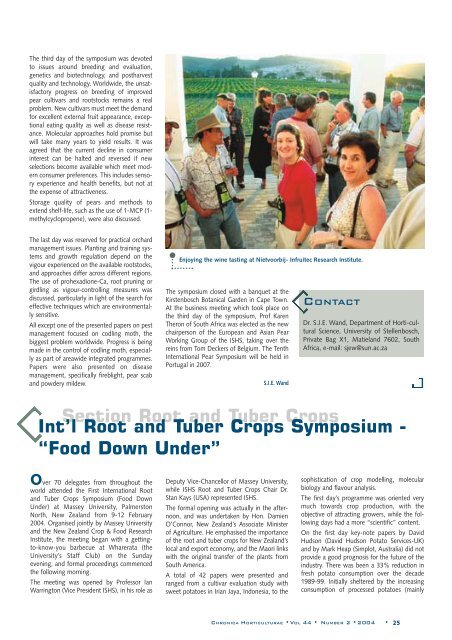Number 2 - 2004 - Acta Horticulturae
Number 2 - 2004 - Acta Horticulturae
Number 2 - 2004 - Acta Horticulturae
You also want an ePaper? Increase the reach of your titles
YUMPU automatically turns print PDFs into web optimized ePapers that Google loves.
The third day of the symposium was devoted<br />
to issues around breeding and evaluation,<br />
genetics and biotechnology, and postharvest<br />
quality and technology. Worldwide, the unsatisfactory<br />
progress on breeding of improved<br />
pear cultivars and rootstocks remains a real<br />
problem. New cultivars must meet the demand<br />
for excellent external fruit appearance, exceptional<br />
eating quality as well as disease resistance.<br />
Molecular approaches hold promise but<br />
will take many years to yield results. It was<br />
agreed that the current decline in consumer<br />
interest can be halted and reversed if new<br />
selections become available which meet modern<br />
consumer preferences. This includes sensory<br />
experience and health benefits, but not at<br />
the expense of attractiveness.<br />
Storage quality of pears and methods to<br />
extend shelf-life, such as the use of 1-MCP (1-<br />
methylcyclopropene), were also discussed.<br />
The last day was reserved for practical orchard<br />
management issues. Planting and training systems<br />
and growth regulation depend on the<br />
vigour experienced on the available rootstocks,<br />
and approaches differ across different regions.<br />
The use of prohexadione-Ca, root pruning or<br />
girdling as vigour-controlling measures was<br />
discussed, particularly in light of the search for<br />
effective techniques which are environmentally<br />
sensitive.<br />
All except one of the presented papers on pest<br />
management focused on codling moth, the<br />
biggest problem worldwide. Progress is being<br />
made in the control of codling moth, especially<br />
as part of areawide integrated programmes.<br />
Papers were also presented on disease<br />
management, specifically fireblight, pear scab<br />
and powdery mildew.<br />
Enjoying the wine tasting at Nietvoorbij- Infruitec Research Institute.<br />
The symposium closed with a banquet at the<br />
Kirstenbosch Botanical Garden in Cape Town.<br />
At the business meeting which took place on<br />
the third day of the symposium, Prof Karen<br />
Theron of South Africa was elected as the new<br />
chairperson of the European and Asian Pear<br />
Working Group of the ISHS, taking over the<br />
reins from Tom Deckers of Belgium. The Tenth<br />
International Pear Symposium will be held in<br />
Portugal in 2007.<br />
S.J.E. Wand<br />
CONTACT<br />
Dr. S.J.E. Wand, Department of Horti-cultural<br />
Science, University of Stellenbosch,<br />
Private Bag X1, Matieland 7602, South<br />
Africa, e-mail: sjew@sun.ac.za<br />
Section Root and Tuber Crops<br />
Int’l Root and Tuber Crops Symposium -<br />
“Food Down Under”<br />
Over 70 delegates from throughout the<br />
world attended the First International Root<br />
and Tuber Crops Symposium (Food Down<br />
Under) at Massey University, Palmerston<br />
North, New Zealand from 9-12 February<br />
<strong>2004</strong>. Organised jointly by Massey University<br />
and the New Zealand Crop & Food Research<br />
Institute, the meeting began with a gettingto-know-you<br />
barbecue at Wharerata (the<br />
University’s Staff Club) on the Sunday<br />
evening, and formal proceedings commenced<br />
the following morning.<br />
The meeting was opened by Professor Ian<br />
Warrington (Vice President ISHS), in his role as<br />
Deputy Vice-Chancellor of Massey University,<br />
while ISHS Root and Tuber Crops Chair Dr.<br />
Stan Kays (USA) represented ISHS.<br />
The formal opening was actually in the afternoon,<br />
and was undertaken by Hon. Damien<br />
O’Connor, New Zealand’s Associate Minister<br />
of Agriculture. He emphasised the importance<br />
of the root and tuber crops for New Zealand’s<br />
local and export economy, and the Maori links<br />
with the original transfer of the plants from<br />
South America.<br />
A total of 42 papers were presented and<br />
ranged from a cultivar evaluation study with<br />
sweet potatoes in Irian Jaya, Indonesia, to the<br />
sophistication of crop modelling, molecular<br />
biology and flavour analysis.<br />
The first day’s programme was oriented very<br />
much towards crop production, with the<br />
objective of attracting growers, while the following<br />
days had a more “scientific” content.<br />
On the first day key-note papers by David<br />
Hudson (David Hudson Potato Services-UK)<br />
and by Mark Heap (Simplot, Australia) did not<br />
provide a good prognosis for the future of the<br />
industry. There was been a 33% reduction in<br />
fresh potato consumption over the decade<br />
1989-99. Initially sheltered by the increasing<br />
consumption of processed potatoes (mainly<br />
CHRONICA HORTICULTURAE •VOL 44 • NUMBER 2 • <strong>2004</strong> • 25
















